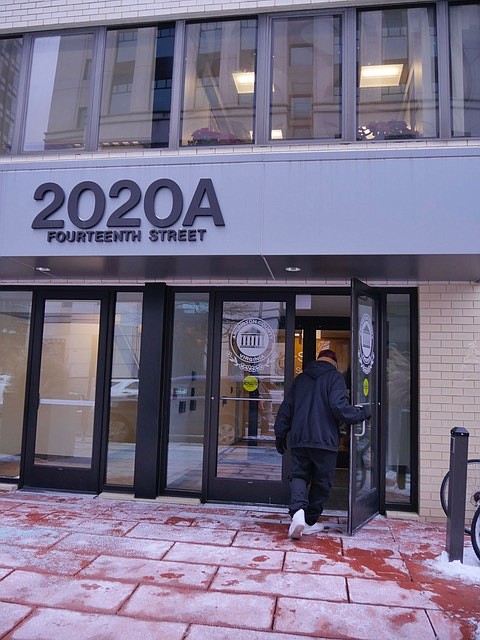It is 4 p.m. on a January afternoon in the Homeless Services Center. Four o’clock is when the homeless clients are allowed to come into the shelter, “and it is very busy,” according to Betsy Frantz, President and CEO of PathForward which runs the center.
When the clients check in, the first step is to get a test for Covid and the flu.
Frantz says there was an outbreak of Covid the third week in December. So they test each client who enters the facility with 55 regular beds and an additional 25 hypothermia beds in the cold or inclement temperature.
“You remember it was warm on Nov. 1 when the HSC hypothermia beds became available but then the temperature plummeted and the shelter filled up. We couldn't take anyone else and used 15 cots at New Hope Housing for a week.”
This January afternoon the clients who test positive will go to the seventh floor which has been designated to house Covid clients. Some of the clients have a regular bed in the shelter and are working with a case manager toward eventual placement in permanent housing. They are housed on the third floor. Other clients are temporary hypothermia overnighters who have come in to escape the bitter temperatures. And they stay on the 3rd floor. Anyone who tests positive is quarantined on floor seven. “Now the floors are separated and we have more people all the time. This increases the need for staff to work more shifts and puts pressure on both staff and homeless clients,” Frantz explains.
Frantz says the hypothermia group is the most transient. “It changes so frequently.” She says, “We try to convince them to stay. Every person who comes in we are happy to have them stay.” Frantz says it is hard to understand during the cold season why some people don’t even want to come inside. She explains It is mostly due to mental illness but it doesn’t feel good to staff. “You can’t eliminate people’s hearts; they are hurting when people don’t come inside.”
Frantz says after the homeless clients check in and are tested they may decide to take a shower or wash their clothes in the evening. There is also a clothing closet with coats and other items where they can choose what they need. Some choose to play the available games and others to read from the selection of books.
In the evening the homeless clients will get a hot meal prepared by the HSC chef. “You walk by the kitchen and it smells amazing,” Franz says. “Glenn Jahnsen can take a chicken and create the most delicious dish. Then he cooks the leftover carcass and chops up the vegetables to make a fantastic soup for the next day. “And everyone loves a little something sweet so if we have that …”
The clients leave the shelter in the morning to allow for cleaning of the premises. “Hopefully we have been able to give them a hot breakfast.” Some clients with a shelter bed will stay in the shelter if they have an appointment with their case manager who is working to help them qualify for housing, make the appropriate choices, inform them of benefits such as SNAP available to them, connect with behavioral health or look for job opportunities if they are able to work.
“It takes many steps along the way.”
Frantz worries that more and more people need to use the system now that the eviction moratorium has been lifted, and many people have lost their homes. She says it took a while for the landlords to evict their tenants and now the shelter is seeing the results. In addition, the temporary extra government benefits related to Covid ended just as inflation was skyrocketing up.
“There are more people over 60 and more with mental illness.”
In addition to increased need for staff, Frantz says the cost of everything is going up and up — blankets, food, “everything we buy.” She adds, “We are trying to be creative. The amount of money coming in isn’t changing so when we have an increase in expenses, it hits the bottom line. So how do we manage?”
Frantz says they see an increased need for medical assistance, not just at the shelter but also for the 125 clients now housed in permanent residences outside the Homeless Services Center. There is a constant need for assistance to monitor and treat the common conditions of cardiac issues, high blood pressure and diabetes that are frequently experienced by this population.
Kasia Shaw, Senior Director of Medical Respite and Nursing Services at the shelter, runs the medical department for any clients in the Day Program and Shelter. In addition the shelter is expanding the medical services to the 125 who are housed in scattered sites. Shaw also heads for the streets with the outreach team and her backpack full of medical supplies for the Mobile Medical Program to help the homeless on the streets.
But Franz’s real hope is to see funding for her vision of a “Dream Team” to supplement these efforts. The dream team would include a nurse, social worker and medical health professional that would serve those housed in the scattered sites and the Mobile Medical Program. Frantz estimates this would cost $300,000 and that it would take five teams to really meet the current needs.
But the bottom line is that “what I think is really important is that the community stepped up here in ways that show compassion. Some communities don’t understand and try the route of law enforcement. They don’t know the rewards of helping. It’s amazing here.”
